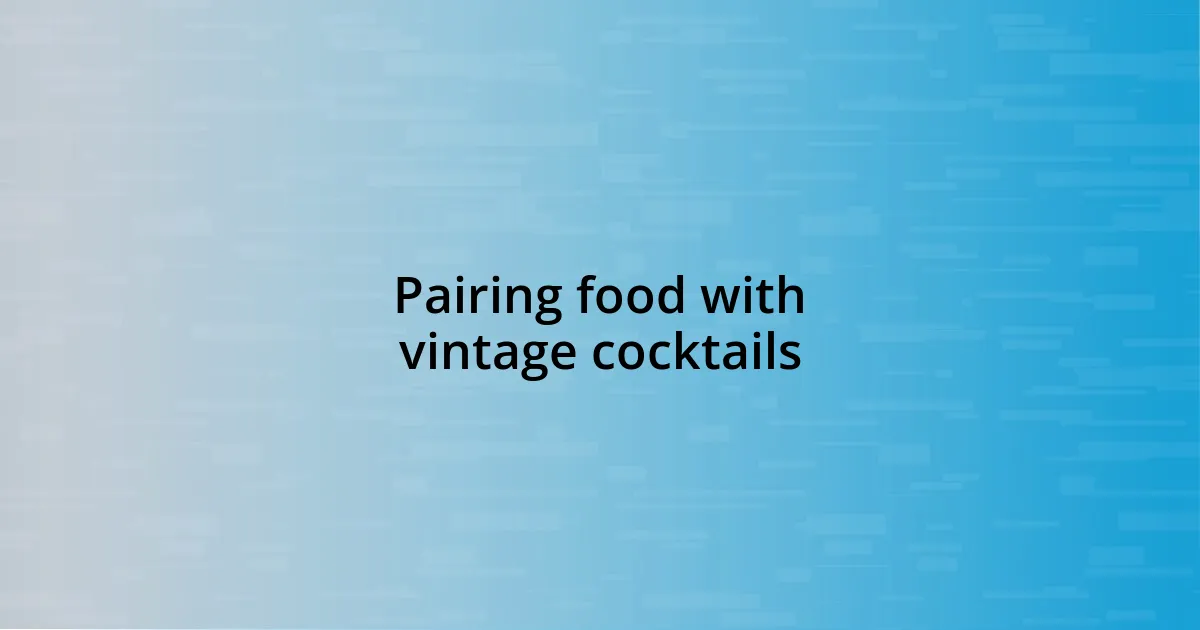Key takeaways:
- Vintage cocktails are drinks with historical significance, often dating back to the 19th or early 20th century, embodying nostalgia and craftsmanship.
- Key ingredients include bitters, artisanal spirits, fresh citrus, and sweet vermouth, all contributing to the complexity and richness of flavors.
- Techniques such as precise measuring, muddling, and chilling glassware significantly enhance the cocktail-making experience.
- Pairing vintage cocktails with food can elevate the overall dining experience, as seen with combinations like Old Fashioned and charcuterie or Martini with smoked salmon.

What are vintage cocktails
Vintage cocktails refer to drinks that have stood the test of time, often dating back to the 19th or early 20th century. They bring an element of nostalgia, embodying a rich history that connects us to the past, much like flipping through a well-worn family album. I can’t help but wonder, doesn’t every sip feel like a trip in a time machine?
When I think about vintage cocktails, I’m reminded of the classic recipes that often require more than just a shake. These drinks usually incorporate traditional ingredients, like bitters or artisanal spirits, that create complex flavors. I remember trying my first Manhattan at a speakeasy-themed bar; the layered taste made me appreciate how a simple combination of whiskey, vermouth, and bitters had survived over decades, telling stories with each sip.
What truly captivates me about vintage cocktails is their craftsmanship. There’s something magical about preparing a drink the way it was done in the roaring twenties. It’s as if each element—the garnish, the glassware—plays a role in a theatrical performance. Have you ever noticed how the way a cocktail is served can evoke a certain mood? That’s part of the charm of vintage cocktails; they invite us not just to drink, but to savor a moment frozen in time.

Historical significance of vintage cocktails
Vintage cocktails hold a significant place in our drinking culture, often serving as a window into the social practices and preferences of bygone eras. When I first learned about Prohibition and its impact on cocktail culture, I was amazed to discover how this historical constraint led to a creative explosion—mixologists innovated under pressure, crafting cocktails that would later become classics. Each drink I enjoy now is steeped in this storied history, invoking the spirit of resilience and rebellion.
Reflecting back on my travels, I remember visiting a bar in New Orleans that celebrated the Sazerac. The bartender shared stories of how this cocktail was originally a medicinal tonic, showcasing the duality of vintage cocktails—they were once part of our everyday lives and are now retro experiences. Each sip felt like participating in a tradition steeped in Southern hospitality, and I couldn’t help but appreciate the layers of history and culture encapsulated in that glass.
On a quieter evening at home, I decided to recreate a classic Daiquiri. As I mixed fresh lime juice with rum and simple syrup, I couldn’t shake the feeling that I was partaking in a ritual that reached back to the 19th century. The idea that my simple mixture connected me to generations of cocktail lovers made the drink taste even better. Vintage cocktails tell stories not just of their ingredients but of the countless people who have savored them throughout history.
| Era | Cocktail |
|---|---|
| 19th Century | Sazerac |
| Prohibition Era | Bee’s Knees |
| 1920s | Manhattan |
| 1930s | Daiquiri |

Key ingredients in vintage cocktails
When diving into vintage cocktails, it’s all about the ingredients that craft each drink’s unique personality. I remember the first time I tasted a classic Negroni—it was the perfect marriage of gin’s botanical notes, sweet vermouth’s richness, and the bitterness of Campari. Each ingredient plays a pivotal role, creating a balanced profile that speaks volumes about the careful thought put into these recipes, making me appreciate the artistry involved.
Here are some key ingredients that often make their way into vintage cocktails:
- Bitters: These are essential for adding depth and complexity; they can turn a simple drink into a flavor journey.
- Artisanal Spirits: High-quality base spirits like whiskey, gin, and rum bring out rich, distinct flavors that elevate the experience.
- Fresh Citrus: Ingredients like lime, lemon, or orange juice not only add a refreshing contrast but also brighten the overall taste of the cocktail.
- Sweet Vermouth: This fortified wine provides sweetness and herbal notes, balancing out the drink’s sharper elements.
- Garnishes: From a twist of lemon peel to a cherry, garnishes serve as the finishing touch that enhances both the aroma and visual appeal.
In my experiences, I’ve often stumbled upon lesser-known ingredients that pleasantly surprised me while making classic cocktails. Recently, I tried incorporating absinthe into a Sazerac. Its herbal notes added a whole new dimension that left me wondering why I hadn’t ventured into that territory sooner. It’s moments like these that remind me of the joy in experimenting within the framework of tradition.

Popular vintage cocktail recipes
When I think of popular vintage cocktails, the Martini immediately comes to mind. I recall an evening where I tried a perfectly crafted dry Martini for the first time. The way the gin mingled with the vermouth was like a dance—smooth, sophisticated, and utterly refined. It made me realize that this cocktail, often associated with elegance, truly embodies a moment in time where glamour was key.
Another classic that holds a special place in my heart is the Old Fashioned. I remember sitting at a dimly lit bar, watching the bartender muddle sugar and bitters with a twist of orange. It was mesmerizing. Every sip transported me to a bygone era of whiskey lovers sitting in grand hotels, savoring life’s simple pleasures. Isn’t it interesting how such straightforward ingredients can create a cocktail that feels so rich in history?
And of course, we can’t forget about the timeless Sidecar. The first time I mixed it, I felt like I was uncovering a secret recipe from the past. The balance of cognac, orange liqueur, and lemon juice taught me the beauty of contrasts—sweetness met with acidity. I sometimes wonder how many stories have been shared over a Sidecar, bridging generations and sparking conversations that continue to bubble at the edges of our memories.

Techniques for making vintage cocktails
When crafting vintage cocktails, the technique is just as vital as the ingredients. I’ve learned the importance of measuring precisely—too much of one ingredient can easily throw off the drink’s balance. There’s something satisfying about watching the pour and feeling the rhythm of the process, almost like a dance. Have you ever considered how a well-shaken cocktail can elevate your experience? My first attempt at making a Daiquiri has lingered in my memory; the combination of shaking ice just right and marrying the flavors became a source of pride that taught me the precision required in these classic concoctions.
Another technique that truly enhances the experience is the art of muddling. I vividly remember the first time I muddled fresh mint leaves for a Mint Julep. The aroma that filled the room was intoxicating! It was a revelation to see how a simple action could release such vibrant flavors. I often find myself wondering why we don’t use this technique more often—it really does evoke the essence of the drink. Muddling isn’t just for cocktails; it’s a metaphor for creativity in our lives—breaking things down to create something beautiful.
Finally, I can’t stress enough the impact of chilling glassware before serving your cocktails. One night, after chilling my coupe glasses, I poured a Lavender Gin Fizz, and it was as if the drink transformed. The colder temperature accentuated the floral notes, enhancing my enjoyment. It’s moments like this that remind me how attention to detail can turn a lovely cocktail into an extraordinary one. Who knew such small choices could lead to deeper appreciation? Every time I pour into properly chilled glassware now, I feel like I’m paying homage to the vintage cocktail tradition.

Pairing food with vintage cocktails
One of the most delightful experiences I’ve had is pairing vintage cocktails with food. The first time I sipped an Old Fashioned alongside a charcuterie board, I felt like I’d stumbled upon a hidden treasure. The rich flavors of the whiskey blend perfectly with cured meats and sharp cheeses, creating an explosion of tastes in my mouth. It made me wonder, isn’t food and drink meant to complement each other like old friends?
I recall a dinner party where I served Martinis alongside smoked salmon crostini. The refreshing, crisp notes of the Gin and the salty-savory profile of the salmon were a match made in cocktail heaven. It amazed me how the classic elegance of the Martini lifted the entire dining experience—did you ever consider how the right cocktail can elevate a meal?
And then there was that unforgettable summer evening when I chose a refreshing Sidecar to accompany a lemon tart. The cocktail’s citrus notes harmonized beautifully with the dessert, creating a delightful dance of flavors. I can still remember the satisfaction of taking a bite, followed by a sip, and how it brought a sense of joy that lingered long after the last bite. Isn’t it fascinating how memories are often tied to what we eat and drink together?
















